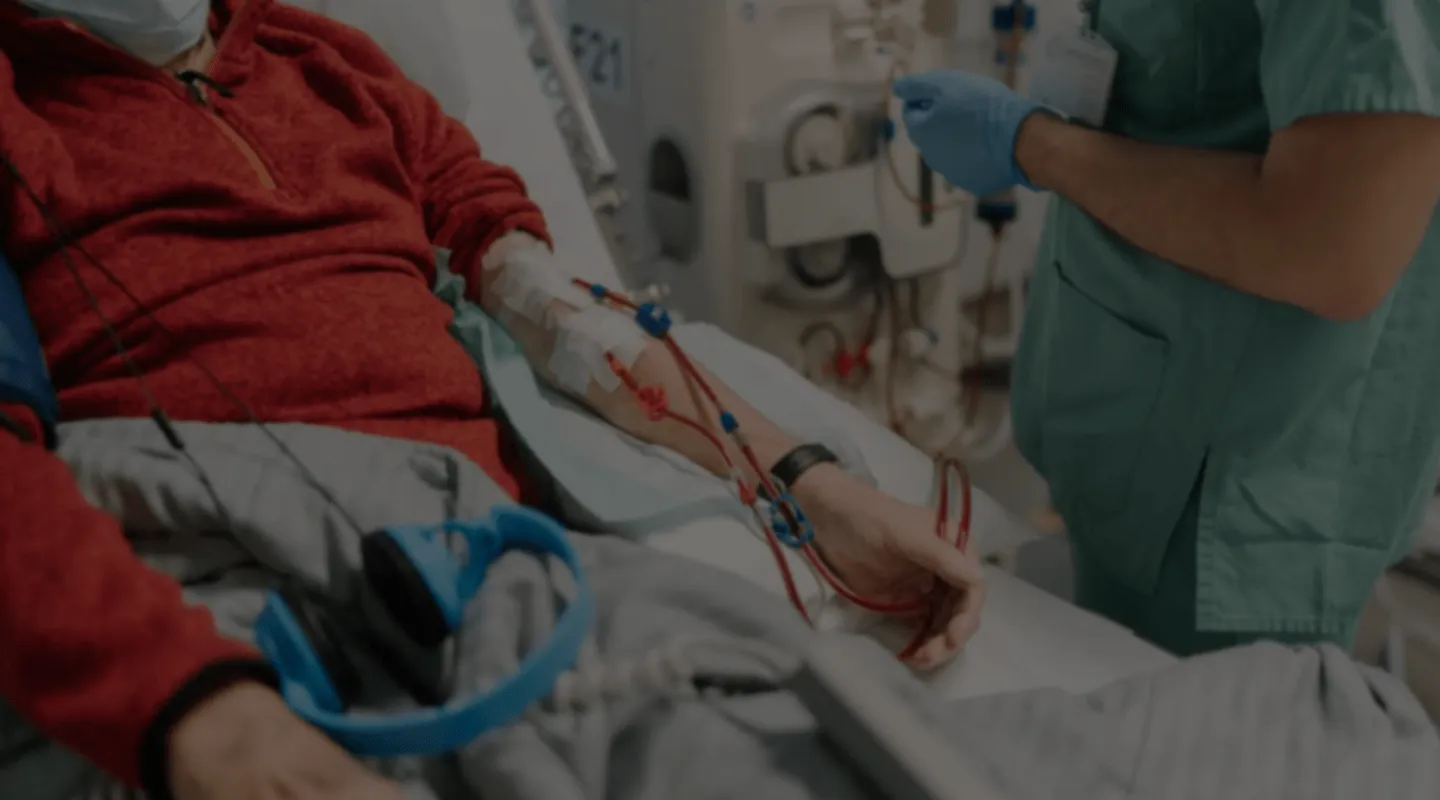
Arteriovenous Fistula for Hemodialysis
Your Arteriovenous Fistula for Hemodialysis in Tunisia at Affordable Prices
Access timely AVF creation surgery for hemodialysis in a quality medical facility
How does it work?
Arteriovenous Fistula for Hemodialysis in Tunisia
Creating an arteriovenous fistula is a surgical procedure that connects an artery to a vein in the arm. The newly created vein, due to its location, will then be easily visible and accessible. The primary goal is to prepare the patient for upcoming hemodialysis sessions and improve the efficiency of the blood draw procedure. Here’s what you should know about this procedure: indications, surgical steps, and post-operative care.
What is Arteriovenous Fistula for Hemodialysis in Tunisia?
For a patient to undergo dialysis under good conditions, adequate blood flow is necessary. Blood flow in the veins can be insufficient, and arteries cannot be punctured frequently. Fortunately, an arteriovenous fistula can be used to connect an artery to a vein in the arm, creating a superficial vein with adequate and easily accessible blood flow. This allows the vein to be punctured as many times as necessary with dialysis needles. The connection will be made in the forearm; for some patients, the fistula can be created in the elbow or arm crease. In some cases, the surgeon will opt for the placement of a synthetic artery to further improve the result. During initial consultations, the different possibilities will be studied based on your case.
How much does fistula placement cost?
Arteriovenous Fistula for Hemodialysis: What You Need to Know Before Surgery
To help you prepare for the operation, several tests and examinations will need to be performed. It begins with a series of medical imaging tests, including a Doppler ultrasound and an X-ray, to precisely locate where the fistula will be created during the surgical procedure. To ensure the smooth running of your operation, it is essential to gather a comprehensive medical file including a health report and blood test results. An appointment with the anesthesiologist will also be scheduled approximately 48 hours before the procedure. This meeting will allow you to discuss your medical history and current treatments to determine the type of anesthesia best suited to your situation.
How is the operation performed?
The procedure is performed under either general anesthesia or local anesthesia (most commonly used); it takes approximately thirty minutes to an hour. The surgeon begins by making an incision to reach the artery and vein, which will be clamped; in this way, the surgeon will be able to perform the necessary steps to connect the artery to the vein. Once this step is completed, it will be possible to restore blood flow. Finally, the incision is sutured. The surgeon performs the procedure using an operating microscope. Hospitalization generally lasts between 24 and 48 hours. It is important to note that following the operation, a 6-week delay is necessary to allow the fistula to form and begin dialysis sessions. The surgeon will inform you of the date on which you will need to have follow-up examinations after leaving the clinic.
What are the post-operative outcomes?
Six weeks after the procedure, follow-up examinations are performed, including a Doppler ultrasound, to verify that the fistula has healed properly and to detect any potential complications. It is important to know the risks before undergoing the procedure, such as the formation of blood clots or abnormal dilation of the vein, which can lead to more or less serious problems. To ensure optimal healing after the operation, the surgeon will provide you with a series of instructions to follow. Among these, it is recommended to avoid sleeping on the side of the fistula and not to wear a watch, bracelet or any other tight object on the arm where the fistula has been created. In addition, it is advisable to wear loose-fitting clothing and avoid lifting heavy objects with the affected arm.
What is the outcome of the operation?
Today, the arteriovenous fistula at the wrist for chronic hemodialysis is a widely practiced surgical procedure worldwide, playing a crucial role in preparing the patient for dialysis sessions. Although it carries risks like any other surgical intervention, the success rate is generally satisfactory. However, if the blood flow obtained through the fistula is insufficient, a new intervention may be necessary to create a new one.
Our advantages


Contact and Request a Quote for Fistula Placement
If you are considering having your fistula placement abroad and wish to organize your stay in Tunisia with a serious and experienced agency, trust the professionals at Tunisia Destination Santé. Our team is always at your disposal to assist and guide you through all the procedures. We are here to guide you every step of the way in creating your file and preparing your stay. Do not hesitate to contact us for more information and to request a free quote without obligation for your fistula placement.
Your health, our priority.
Request your free quote.
Frequently Asked Questions
The durability of a fistula depends on several factors, including the quality of the blood vessels, the surgical technique used, post-operative care, and patient cooperation in following care recommendations.
Hypertension can put excessive pressure on the fistula, leading to abnormal dilation or premature failure of the fistula. Strict blood pressure control is crucial.
Rare complications can include fistulas aneurysms, limb ischemia due to blood steal syndrome, or severe infection resistant to standard treatments.
Yes, patients may benefit from venous grafts or temporary dialysis catheters. In some cases, prosthetic arteriovenous fistulas can be used.
Early signs include a decrease in fistula bruit (thrill), decreased blood flow, localized pain, redness or swelling, and repeated access difficulties during dialysis sessions.
A balanced diet rich in essential nutrients and proteins can promote healing and maintenance of blood vessels, thus contributing to the longevity of the fistula.
Forearm strengthening exercises, such as squeezing a rubber ball, can help dilate and strengthen the veins before fistula creation.
Quality sleep promotes tissue regeneration and blood circulation, which can have a positive impact on the healing and maintenance of the fistula.
Innovations such as the use of advanced imaging techniques during surgery, improved graft materials, and microsurgical techniques can increase fistula success rates.
Patients may experience anxiety, stress, and depression related to the procedure and the need for regular dialysis. Psychological support and support groups can be beneficial in managing these impacts.
